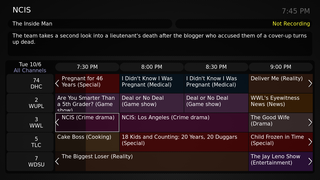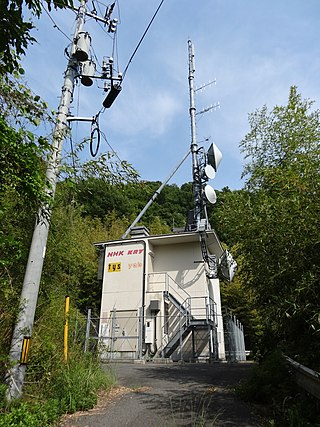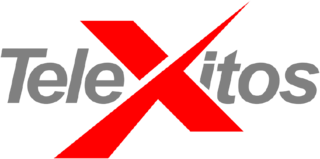Related Research Articles

A television channel is a terrestrial frequency or virtual number over which a television station or television network is distributed. For example, in North America, channel 2 refers to the terrestrial or cable band of 54 to 60 MHz, with carrier frequencies of 55.25 MHz for NTSC analog video (VSB) and 59.75 MHz for analog audio (FM), or 55.31 MHz for digital ATSC (8VSB). Channels may be shared by many different television stations or cable-distributed channels depending on the location and service provider

Ion Television is an American broadcast television network owned by the Katz Broadcasting subsidiary of the E. W. Scripps Company. The network first began broadcasting on August 31, 1998, as Pax TV, focusing primarily on family-oriented entertainment programming. It rebranded as i: Independent Television on July 1, 2005, converting into a general entertainment network featuring recent and older acquired programs. The network adopted its identity as Ion Television on January 29, 2007, and airs programming in daily binge blocks of one program, usually acquired procedural dramas. The network also carries some holiday specials and films before Christmas.

Terrestrial television or over-the-air television (OTA) is a type of television broadcasting in which the signal transmission occurs via radio waves from the terrestrial (Earth-based) transmitter of a TV station to a TV receiver having an antenna. The term terrestrial is more common in Europe and Latin America, while in Canada and the United States it is called over-the-air or simply broadcast. This type of TV broadcast is distinguished from newer technologies, such as satellite television, in which the signal is transmitted to the receiver from an overhead satellite; cable television, in which the signal is carried to the receiver through a cable; and Internet Protocol television, in which the signal is received over an Internet stream or on a network utilizing the Internet Protocol. Terrestrial television stations broadcast on television channels with frequencies between about 52 and 600 MHz in the VHF and UHF bands. Since radio waves in these bands travel by line of sight, reception is generally limited by the visual horizon to distances of 64–97 kilometres (40–60 mi), although under better conditions and with tropospheric ducting, signals can sometimes be received hundreds of kilometers distant.

Station identification is the practice of radio and television stations and networks identifying themselves on-air, typically by means of a call sign or brand name. This may be to satisfy requirements of licensing authorities, a form of branding, or a combination of both. As such, it is closely related to production logos, used in television and cinema alike.
CBC Television is a Canadian English-language broadcast television network owned by the Canadian Broadcasting Corporation, the national public broadcaster. The network began operations on September 6, 1952. Its French-language counterpart is ICI Radio-Canada Télé.
A television station is a set of equipment managed by a business, organisation or other entity such as an amateur television (ATV) operator, that transmits video content and audio content via radio waves directly from a transmitter on the earth's surface to any number of tuned receivers simultaneously.

People's Television Network is the flagship state broadcaster owned by the Government of the Philippines. Founded in 1974, PTV is the main brand of People's Television Network, Inc. (PTNI), one of the attached agencies under the Presidential Communications Office (PCO).
The class A television service is a system for regulating some low-power television (LPTV) stations in the United States. Class A stations are denoted by the broadcast callsign suffix "-CA" (analog) or "-CD" (digital), although very many analog -CA stations have a digital companion channel that was assigned the -LD suffix used by regular (non-class-A) digital LPTV stations.

Mississippi Public Broadcasting (MPB) is the public broadcasting state network serving the U.S. state of Mississippi. It is owned by the Mississippi Authority for Educational Television (MAET), an agency of the state government that holds the licenses for all of the PBS and NPR member stations in the state. MPB's headquarters is located on Ridgewood Road in northeast Jackson. The public broadcaster was established as Mississippi Educational Television.
In broadcasting, digital subchannels are a method of transmitting more than one independent program stream simultaneously from the same digital radio or television station on the same radio frequency channel. This is done by using data compression techniques to reduce the size of each individual program stream, and multiplexing to combine them into a single signal. The practice is sometimes called "multicasting".

WTMO-CD is a low-power, Class A television station in Orlando, Florida, United States, broadcasting the Spanish-language Telemundo network. Owned and operated by NBCUniversal's Telemundo Station Group, the station has studios at the intersection of Sand Lake Road and Orange Blossom Trail in unincorporated Orange County, and its transmitter is located on Lake Sparling Road in Pine Hills.
Digital terrestrial television in Canada is transmitted using the ATSC standard. Because Canada and the U.S. use the same standard and frequencies for channels, people near the Canada–United States border can watch digital television programming from television stations in either country where available. The ATSC standards are also used in Mexico, the Dominican Republic, Suriname, and South Korea.

A broadcast relay station, also known as a satellite station, relay transmitter, broadcast translator (U.S.), re-broadcaster (Canada), repeater or complementary station (Mexico), is a broadcast transmitter which repeats the signal of a radio or television station to an area not covered by the originating station. It expands the broadcast range of a television or radio station beyond the primary signal's original coverage or improves service in the original coverage area. The stations may be used to create a single-frequency network. They may also be used by an AM or FM radio station to establish a presence on the other band.
In the broadcasting industry, a network affiliate or affiliated station is a local broadcaster, owned by a company other than the owner of the network, which carries some or all of the lineup of television programs or radio programs of a television or radio network. This distinguishes such a television or radio station from an owned-and-operated station (O&O), which is owned by the parent network.
The digital transition in the United States was the switchover from analog to exclusively digital broadcasting of terrestrial television programming. According to David Rehr, then president and CEO of the National Association of Broadcasters, this transition represented "the most significant advancement of television technology since color TV was introduced." For full-power TV stations, the transition went into effect on June 12, 2009, with stations ending regular programming on their analog signals no later than 11:59 p.m. local time that day.

The Public Broadcasting Service (PBS) is an American public broadcaster and non-commercial, free-to-air television network based in Arlington, Virginia. PBS is a publicly funded nonprofit organization and the most prominent provider of educational programs to public television stations in the United States, distributing shows such as Frontline, Nova, PBS NewsHour, Arthur, Sesame Street, and This Old House.

TeleXitos is an American Spanish language digital multicast television network owned by NBCUniversal Telemundo Enterprises, a subsidiary of the NBCUniversal Filmed and Entertainment division of NBCUniversal. Aimed at the Hispanic and Latin American community, the network airs a mix of dramatic television series from the 1970s to the 2000s and movies, with all programming consisting of shows dubbed into Spanish.